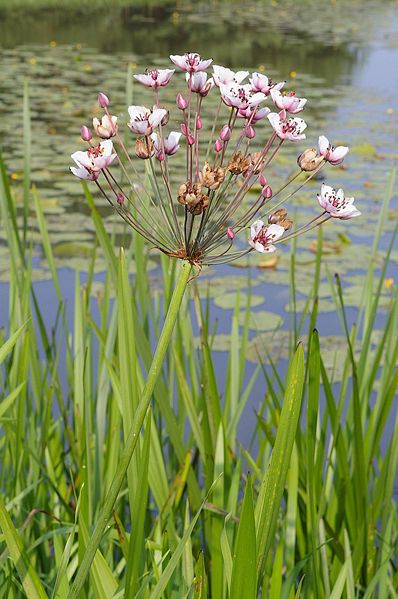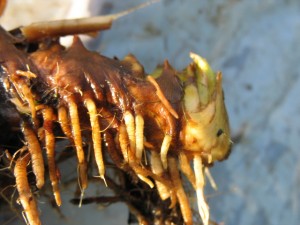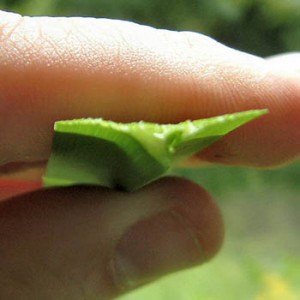In one area of its native range — Israel — it’s endangered becauses of dwindling habitat. In another part of the world it is an invasive weed, and you can bet where it is an invasive weed — the Great Lakes area — no official mentions that, oh by the way, it’s edible.
I am going to date myself but I was an intense fan of the original production of Connections with James Burke, circa 1979. An extremely accomplished science writer he’s still famous for his live walk on and narration of a rocket launch at Kennedy Space Center that I also saw. Perfectly time he talked down to the last second and lift off without a mistake. It is regarded not only as one of the best performances by a science reporter but among the gutsiest. In these days of digitization and retakes the mundane can become the remarkable. Burke did the remarkable the hard way decades ago. If you watch this video remember that from the waking part on it was done live in one take. What you don’t see is off screen is an assistant silently doing the count down with hand gestures. The camera crew in the final shot were also standing on a fire ants nest and had to endure some 15 seconds of their stinging attack. After you watch that here’s a follow up some 35 years later with Burke in the last five minutes talking about that famous shot.
When Burke started to write Connections he said he just followed the trail. He had a non-linear view of history. I did the same thing when I wrote “Indian Pipes, Gold and Emily Dickinson.” Botany in isolation will put you to sleep. When I decided to create a post called the “Only Plant In Its Genus” I wanted to find all of the edible plants that were the only plant in their genus, just to see where it would take me. Along the way I found some unexpected things, among them the Flowering Rush.
Let’s start with the fact that the Flowering Rush is not a rush. And as you might guess as a member of a monotypic genus botanists had and have a hard time classifying it… When in doubt, a cat washes, when botanists are in doubt they make it monotypic though there is some debate about that. Some argue the version in North America has some subtle differences than those in Eurasia and that there should be two species, Butomus umbellatus and Butomus junceus. Others say the differences are either not differences or just plain don’t exist. In the decades to come perhaps a decision will be made on that. Historically the Flowering Rush was a common food in Northern Europe particularly Russia where food sometimes was scarce.
The perennial was first collected in North America near Laprairie on the St. Lawrence River in 1905 but it was seen as early as 1897 (not 1879, that’s an internet replicated typo.) It was officially collected near Detroit in 1930 by O. A. Farwell who noted it had been there since before 1918. Now the Flowering Rush, also called the Water Gladiolus, is basically found in the northern half of the United States and the lower half of Canada. Humans, moving water, ice and muskrats help spread the plant, the latter because they use it to build their mounds. The root has edible starch, a point no doubt not missed by the muskrats.
Butomus (BEW-toe-mus) is bastardized Greek from bous meaning ox and temno meaning to cut. The leaves are sharp enough to cut a cow’s muzzle. Umbellatus (um-BELL-ah-tus) means with umbells, a reference to the flowers. We are told that in Dead Latin it was called Buxus but Buxus is now a totally different genus altogether.
Green Deane’s “Itemized” Plant Profile: Flowering Rush
IDENTIFICATION: Butomus umbellatus: Flowering aquatic plant to five feet. Leaves are thin, straight, sword-shaped, triangular, pointed up to 40 inches (one meter long.) They grow in two rows from a rhizome. The leaves are also untoothed, parallel veined and twisted, submerged leaves however are limp. The flowers grow on tall, cylindrical stalks with umbrella-like clusters of twenty to fifty flowers. They have three large pale pink petals each — sometimes white — and three lower, smaller sepals that are also pale pink and resemble petals. Blossoms have six pistils that are simple, whorled, united at the base. The fruit is an indehiscent, many-seeded capsule. The plant looks like a bulrush when not flowering but is missing the bulrush’s tuff of seeds. Base of flower stalk can have bulbils (tiny bulbs) and the rhizome rootlets.
TIME OF YEAR: Flowers from June to September
ENVIRONMENT: Mud, ponds, canals, ditches, edges of still or slowly moving water to about 10 feet deep. Will not grow in shade.
METHOD OF PREPARATION: Removed bubils and rootlets, peel rhizome, boil, changing water helps. They can also be roasted. Alternatively cleaned rhizome can be dried then ground. Check to make sure it is not acrid after drying or roasting. Used as a thickener or added to flour. Is more than half starch. Harvested also plants make excellent compost.






Where did the Flowering Rush originally come from?
Europe.
What does the flowering rush eat and where does it stand in the food chain.
It seems to me that given the flowering habit, the shape of the leaves, and the bulb-like roots this plant should be in the genus Allium. Its clearly related (perhaps somewhat distantly) to garlic, and onions, and leeks. It is the only aquatic Allium species that I’ve heard of so far though, so perhaps that’s what is throwing people off (also the seeds are really small unlike most Allium spp). I would be very interested to hear how it tastes fresh, or even cooked.